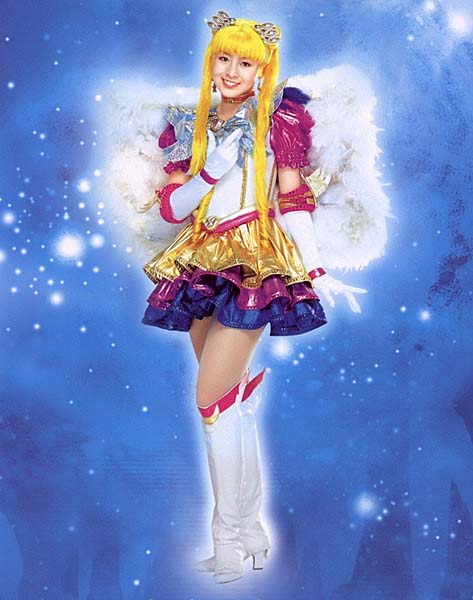
Miyuki Kanbe, the third actress to play Sailor Moon in the SeraMyu musicals, died Wednesday of heart failure at the age of 24.
(Picture from here.)
Trivia that matter

Miyuki Kanbe, the third actress to play Sailor Moon in the SeraMyu musicals, died Wednesday of heart failure at the age of 24.
(Picture from here.)
It’s been a while, hasn’t it? Life’s been very interesting lately, in ways both good and bad, and there’s little time for anime. I’ll be back eventually.

I finally watched the first episode of Toshokan Sensou, a.k.a. Library War. It looks like my spring viewing will be Kaiba, Allison and Lillia, Real Drive and maybe Kurenai, ((I had some problems with the first episode of Kurenai, but so many people have declared it to be one of the best this season that I probably will give it a second chance.)) with Soul Eater and perhaps Wagaya no Oinari-sama for essential fluff.
But not Toshokan Sensou. I could tolerate the absurd premise — the brain police (i.e., “committees of Media Improvement Act”) raid bookstores and confiscate such dangerous literature as books of fairy tales, while a branch of the military defends libraries — if the anime has compensating virtues. And it is a Production I.G. series broadcast in the Noitanima timeslot, so I would expect the show to be better than average. However, the protagonist is a hot-headed fool, too thoughtless to be sympathetic. Toward the end of the episode she rashly attempts to halt a bookstore raid by invoking her authority as a “Private First Class Librarian,” unaware that she needs to be at least a lieutenant to do so. At that point I quit watching. Toshokan Sensou may be intended to be part comedy, but Kasahara is too dumb and annoying to be funny.
At least five groups are subbing Kanokon. Three episodes have been translated so far. Only one group is subbing Kaiba, and only the first episode is available in English. You couldn’t pay me to watch Kanokon. Kaiba is probably the most interesting show since Denno Coil.
There’s something wrong here.
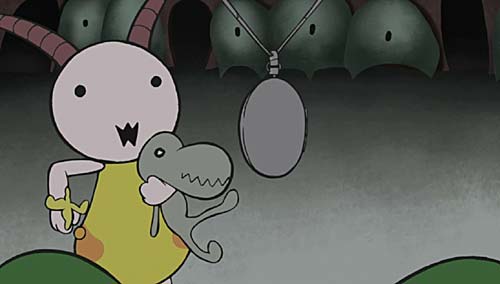
A few notes on the first episode of Kaiba:
• It’s dystopian science fiction. In this world, minds can be separated from bodies and stored on conical “chips.” There’s a market for memories and bodies, and young bodies fetch good prices. The rich, who live above the electrical clouds, can avoid death by obtaining fresh bodies. It’s a dangerous world for the commoners, who are constantly beset by automatons.
• The first episode was mostly scene-setting and action, and I don’t have much sense of the characters yet. The main ones so far are “Warp,” a boy with no memory who has a locket with a girl’s picture, an emblem of three discs on his abdomen, and a hole through his chest, and Popo (voiced by Romi Paku), who seems to be a streetwise kid, perhaps with radical political connections (though we don’t know that much about him yet).
• The art and animation are more interesting than the story and characters so far. I’ve posted some screen captures below the fold, and there are a couple of excerpts on the video weblog illustrating the quality of the animation and the strangeness. The electronic music soundtrack might be worth tracking down when it’s available.
• Visual novelties and energy can carry the show for a while, but whether Kaiba is ultimately a triumph or a disappointment depends whether it tells a good story. For now, it’s at the top of my watch list.
I uploaded a couple of contrasting short excepts from Masaaki Yuasa‘s Mind Game to the video weblog to illustrate why I am so impatient to see Kaiba.
Although Yuasa wrote the script for and directed Mind Game, the movie was based on manga by Robin Nishi, which is also the name of the main character. I doubt that the manga is rigorously autobiographical. Nishi’s website is here; it includes a selection of his work and a gallery.
Yuasa’s credits include Cat Soup and Kemonozume, which, like Mind Game, are not for chldren. Despite the simple character designs, I gather that Kaiba isn’t a kid’s show, either.
*****
Quote of the week:
I will personally be nowhere near this. It sounds like my worst nightmare.
See here for context. (Hint: think blue, count a lot more than two.)
Bonus quote:
Damn ! I so wanted to make this. Oh why oh why did I plan to watch paint dry on the same days !
*****
Fuyumi Ono’s target demographic is youngsters who fantasize that they are adopted. In The Twelve Kingdoms: Sea of Shadow, misfit schoolgirl Youko discovers that she actually comes from Another World, where she has a Great Destiny. In the newly-translated Twelve Kingdoms novel, Sea of Wind, a boy learns that not only does he not belong in the Japanese family where his grandmother makes him and his mother miserable, but that he is not even human.
I don’t have time to write a review — maybe later — but I will note that Sea of Wind is a pretty good story, though less ambitious than the preceeding volume. I don’t know if I ever will watch the anime based on the books. According to what I’ve read, the anime made many changes to the stories, most of which I would probably find objectionable. (I gather that the anime Youko is a much less sympathetic character than the character Ono wrote about.) However, I do plan to read all the books as they become available.
According to Nick, the book Ono wrote that led to the Twelve Kingdoms series may not be released in the USA. Fortunately for me, there is a fan translation available (though I strongly prefer to read fiction as ink on paper rather than as pixels on a monitor).
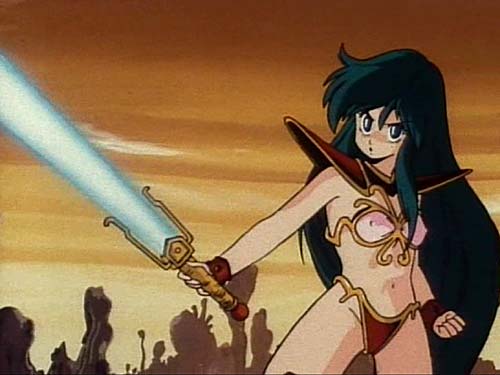
Private investigator Rem Ayanokouji can enter into other people’s dreams, where she battles demons who cause nightmares and steal dreamers’ life force. Her activities were chronicled in several Dream Hunter Rem OVAs dating from 1985 to 1992. According to the Wikipedia article, the first episode was originally hentai, but it was so popular that the makers skipped the pornography in subsequent episodes to appeal to wider audiences. The first episode was re-released in a cleaned-up “special version.”
Only the later version of the first episode has been fansubbed, and it may just be the first half of an hour-long episode. ((I did come across a listing of another episode, but it was labeled “hentai,” and I’m not that curious.)) It’s not exactly a masterpiece, but it does have a certain creaky charm.
Here’s the first batch of this season’s rejects.
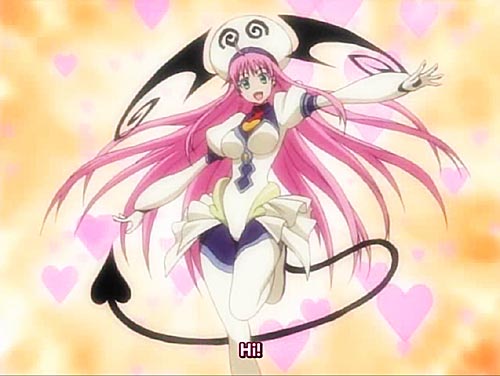
Against my better judgement, I watched the first episode of To Love-Ru. It starts off as an action-in-space thriller, but that’s deceptive. As the opening makes abundantly clear, the show is actually a fanservice vehicle with occasional laughs and perhaps a bit of a story. Lala has run away from her home planet to avoid an arranged marriage. She’s an inventor, albeit a ditzy one who doesn’t always remember how to turn off her contraptions. She’s pleasantly curvaceous, and she is not the least bit self-conscious about materializing naked in someone else’s bathtub. When she does get dressed, she wears her “costume robot,” undergoing a quasi-mahou shoujo transformation in the process.
The bathtub she arrives in was occupied at the time by the luckless Rito, who spends most of the episode blushing. By the end he has managed to accidentally propose to the alien Lala (she doesn’t have horns, but she does have a tail), who is enthusiastic about the prospect. Sound familiar? At least Rito isn’t a jerk like Ataru, but his dithering and overreactions make him just as annoying.
The premise of To Love-Ru does have some possibilites, but so did that of Rosario + Pantsu. Never mind.
By the way, why the skittishness about showing nipples? We see almost every inch of Lala, but there’s always something — strands of hair, Rito’s hands — hiding the nipples. (Wolf and Spice is downright weird: Horo’s breasts are smooth and featureless.) Urusei Yatsura and Ranma 1/2 were far less concerned with fanservice, and they weren’t coy about showing the entire breast.
*****
If you would like to earn the Kawaii Menace Award for Service to Humanity, devise a player for matroska on Macintosh that really works, or a utility to convert soft-subbed MKVs to hard-subbed AVIs. VLC will kinda play MKVs, but it handles soft subtitles poorly. The majority of the MKVs I’ve downloaded require more processing power than my aging mac and its video card are capable of. (I had hoped to do some upgrading this year, but medical and dental bills take priority in the budget. Bleah.) Sometimes these will play on my machine at the office, and I spent lunch yesterday watching the first episodes of a couple of new shows, Kurenai and Zettai Karen Children.
The opening of Kurenai is bright and cheerful, showing simplified versions of the characters dancing. The show itself, however, is a rather dark action drama so far. In the first episode high school student Shintaro accepts the job of guarding Murasaki, a very young ojou. Beyond that, I really can’t say what it’s about. There are a lot of characters introduced, including several women with Red Garden noses, and hints of complicated backstories. Spying is a frequent motif, with characters observing other characters from a distance or listening at the door.There might be an intricate story developing here, or it could just be poorly-thought-out drivel.
I have serious problems with the premise. Shintaro accepted the bodyguard job even though he knew that he would leave Murasaki alone in his room during the day while he’s at school. Uh-huh. His employer offered him the job knowing that this would be the case. Sure. Shintaro doesn’t think to ask why Murasaki needs a bodyguard. Perhaps all will be satisfactorily explained in later episodes, but I have better uses for my lunch hour
*****
Zettai Karen Children features Aya Hirano, and that’s its only salient feature. Her performance is noteworthy because there’s nothing noteworthy about it; it’s a competent portrayal of an annoying ten-year-old girl and nothing more. Her character, Kaoru, is one of three little girls with paranormal abilities, the “Absolutely Lovely Children.” This dirty trio (there’s likely to be considerable collateral damage when they’re involved) are deployed in the first episode to deal with a jerk who turns bystanders to stone while wreaking havoc. It may sound like a kid’s show, but it’s intended for an older audience: the jerk is stereotypically gay, and Kaoru is obsessed with breast sizes and the like — a peculiar trait in a prepubescent girl. It’s not a bad show; it’s just not very good, and not worth my lunch hour.
*****
The above are the weakest of the recent releases I’ve seen. Fortunately, there are better shows. While nothing yet has grabbed me the way the first episode of Denno Coil did a year ago, Allison and Lillia and Special A both started off well, and Chii’s Sweet Home has the virture of brevity. My favorite thus far is Soul Eater, not so much for the story as for the art and especially the animation. ((I just noticed that one of the characters listed is “Sid Barett.” Does somebody on the staff listen to early Pink Floyd?)) I’m also waiting impatiently for the fansubs of Library Wars and Kaiba.
If you are sick of reading negative comments about the Anime Blog Awards, skip the rest of this.
Here’s a curiosity: Iblard Jikan. It’s a Studio Ghibli project based on the paintings of Naohisa Inoue of the imaginary world Iblard. There’s no story; instead, it’s thirty minutes of looking at surrealistic paintings. It’s not as dull as it sounds. The paintings are enhanced with discreet animation: rivers sparkle, waves roll up beaches, trams glide on tracks, girls fly. There’s no dialogue, just instrumental music (mostly bland, but a few of the pieces are listenable). If you pay attention to the backgrounds when you watch animated features, you might find Iblard Jikan worthwhile. There are more screen captures below the fold.
Those who enjoy jigsaw puzzles will want to visit this page.
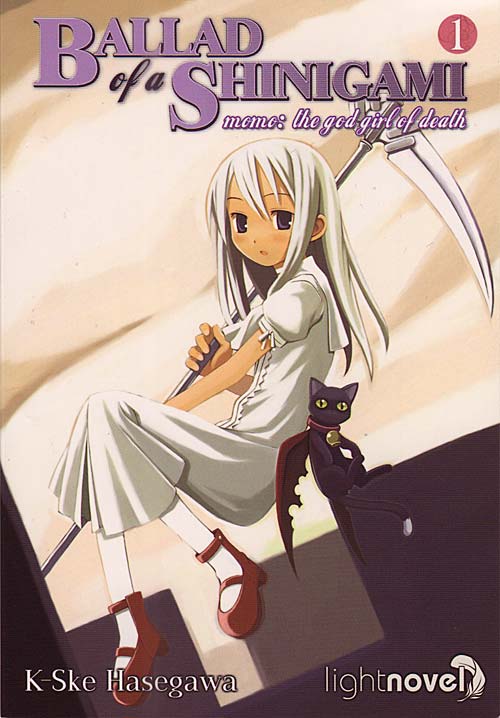
The typical shinigami, according to K-Ske Hasegawa in Ballad of a Shinigami: Momo, the Girl God of Death, Volume 1, atones for the crime of taking his own life by delivering death and collecting souls. He remembers only his suicide and one memory of his past life. His grim nature is reflected in his black color.
Momo, however, remembers nothing at all about her past life. She may carry a scythe, but she wears white, her hair is white and her complexion is like snow. She wears shiny red shoes. Only her eyes are dark. Unlike other shinigami, who conduct their tasks in a business-like manner, Momo takes an interest in the humans whom she encounters. This exasperates her servant demon, the winged cat Daniel.
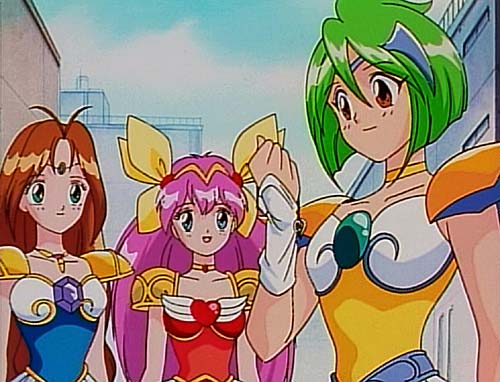
When the world needs saving, Americans turn to superheroes: neurotic, grandstanding, steroid-abusing macho jerks. The Japanese rely on mahou shoujo: pretty girls in short skirts. Advantage: Japan. (The Japanese also call upon giant mecha, for which there is no specifically American equivalent. Advantage: America.)
Different magical girls have different specialties. School girl Momoko Hanasaki, along with her friends Yuri and Hinagiku, is a “love angel.” When agents from the demon world possess humans in attempts to destroy the happiness of those in love, Momoko transforms into “Wedding Peach” and tells the demons that she is extremely displeased. Then she exorcises them with attacks powered by her Love Wave.
I first read about Wedding Peach at T.H.E.M. Anime, where it was invariably mentioned with scorn. As I recall, the review there said it was stupid enough to cause brain damage in children. (That review has since been replaced by a more temperate, but still snide, assessment.) I figured that this was a series I could skip. However, I noticed that reviews elsewhere were more positive. The comments on this thread at Steven’s piqued my curiousity, and when I noticed that the discs were on sale for $4 each, I figured that it might be worthwhile to watch the first and see just how bad it is.
Actually, the first six episodes are quite watchable. Wedding Peach is plainly modeled closely on Sailor Moon (not that surprising, given that the character designer and one of the writers are alumni of the earlier show). However, thus far it seems to be not so much a cheap ripoff of Sailor Moon as Sailor Moon done right. Momoko is not a stupid ditz like Usagi. When she and her friends invoke their superpowers and battle the forces of evil, they’re competent. They don’t have to be rescued every episode by a mysterious yet dorky guy wearing a mask. It’s clear early on that the guy with whom Momoko regularly quarrels is destined to be her romantic interest, and it’s clear to them as well, though they won’t admit it.
It’s also ridiculous. Each of the three girls undergoes a double transformation in becoming a love angel, First she magically dons a wedding gown, which she then changes to a much-abbreviated combat dress. I’ve posted Momoko’s transformation on my video weblog. The long-term story apparently involves finding the evocatively-named “Saint Something Four.” Tongues were in cheeks when this show was made.
I haven’t decided if I’m going to watch the rest of it. It’s not exactly great art. There are any number of better shows available, and unless you have a special interest in magical girls, I don’t recommend it. It’s probably not even that good a substitute for Sailor Moon. Part of the appeal of the latter is the intricacy of the universe developed over the course of five seasons of anime, eighteen tankoubon of manga, three movies, a live-action show and a series of musicals. Wedding Peach offers only a mere 51 episodes plus four OVA episodes.
I’ve been following the “March madness” at Derailed by Darry. It’s depressing; it demonstrates yet again that popular taste is a lousy guide to quality. In search of further bad news, I took a close look at the list of the “Top 50 best rated” animes at ANN. ((There are two different lists of the “best,” each calculated differently, but both essentially the same. This one is the “bayesian estimate.”)) Here it is, with my comments:
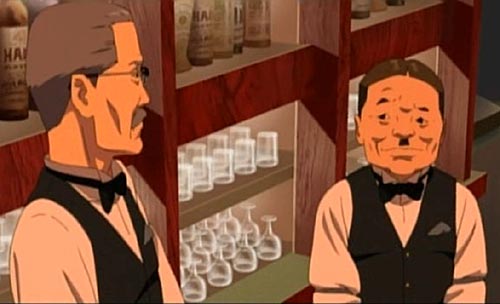
Some good news: Andrew Driver, who translated Yasutaka Tsutsui’s Salmonella Men on Planet Porno, is currently translating Paprika. It should be out next year. I wonder if anyone is working on Toki wo Kakeru Shoujo?
In case there is anyone here who hasn’t yet seen the movie, here are the opening credits of Paprika, perhaps the best part of the show.
*****
N.Z. Bear has been making adjustments to the TTLB ecosystem. I discovered today that The Kawaii Menace has vaulted into the “Large Mammal” category, even though it ranks only #7,097 (or #7,111, depending on where you look) at this moment. My first, now defunct weblog ranked much higher several years ago but never got beyond “Adorable Rodent” status. This all means almost as little as Technorati “authority.”
Yeah, it’s been quiet around here. I haven’t seen much anime lately, and what I have watched have been mostly old favorites, such as the first disc of Haibane Renmei last night. None of the current series have caught my interest the way Denno Coil and Oh! Edo Rocket did last year. (Shigofumi might have, but it’s out of reach now.) The only one I’m following at this time is Hakaba Kitaro.
I did order the first discs of a few older series I’m curious about, which should arrive in a week or two. Once I’ve figured out how I’m going to manage all my medical bills, I’ll probably finally purchase some of the series that have long been on my list. These include Fantastic Children, Witch Hunter Robin, The Twelve Kingdoms, PlanetES and the rest of Revolutionary Girl Utena.
What I’m most looking forward to is not anime, however, but books. The first volume of The Twelve Kingdoms is very good (better than the anime, I suspect), and the second is due out later this month. The second volume of Kino no Tabi is due out anytime, though none of the sources I’ve checked have listed a publication date, grrr. There are also two more installments of Crest of the Stars available.